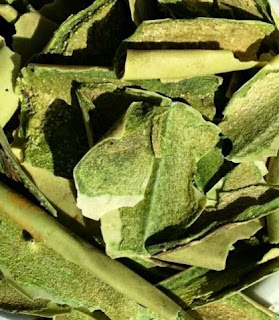Ode to the Sacred Cacti
Open Discussion on Cacti - San Pedro / Peruvian Torch
Tuesday, May 5, 2015
Combretum quadrangulare (Sakae Naa)
Combretum Quadrangulare – Sakae Naa: The Sakae Naa (Latin name Combretum quadrangulare) is one of the many medicinal herbs in the world. Sakae naturally produces a compound known as “Combretol”. Combretol is an O-methylated flavonol that’s found in C. quadrangulare. Chemicals such as these are the source of plants medicinal and psychoactive powers. The leaves or foliage is used to relieve muscular pain.
Common Use of Sakae Naa: There are many different ways that you can use the leaves of the Sakae Naa. If you purchase them raw and in their original state you can either chew them or eat them. If you decide to chew the leaves, then it would be best to slowly chew them and keep them in your mouth for as long as possible. By doing this, the beneficial minerals in the leaves will enter your body through the soft tissue of your cheeks and reach your circulatory system. If you prefer to eat the leaves, then it is suggested that you turn them into powder first.
Saturday, February 9, 2013
Friday, February 8, 2013
Best source of Peruvian Torch and San Pedro Incense
Lets talk about San Pedro and Peruvian Torch Incense Powder
Peruvian Torch Incense Powder is heavily sought after and hardly captured.The best sources for San Pedro and Peruvian torch vary and most online stores charge a fortune. Most retailers sell for $1.75 to $2.15 a gram.
Some people cannot tell the difference between San Pedro or Peruvian Torch powder.It is hard to determine by sight alone.Some people say they can smell it or they can tell by the effects.There is no sense in arguing the fact,unless you are a scientist with proper lab equipment or you grew the succulent yourself and know the type or strain, you haven't a clue of what type of succulent it is.
Some many people are Legal High and Erowid scholars.They read a few articles and suddenly they are an experts on dosage, suppliers and law.These few individuals are misinforming the public about Entheogens. Erowid is a great source for information , but it should not be a rubric for all uncontrolled or controlled substances. Just research the plant by its scientific name to get a better understanding of the plants spirit and culture surrounding the plants origination.
The Entheogenic community is growing and the demand for these products has increased. Unfortunately, the supply is extremely lower than the demand. This drives prices higher and creates a false sense of scarcity. For plenty of people when its in season they say,"Its time to stock up!" But in all actually it is better to order a smaller quantity before making a huge purchase.Contact the seller and ask if they have smaller quantities before you spend $400.00 on a pound of old green powder from who knows where. We have purchased product from the company listed below.Read our review
( no Minimum purchase) Natural Ether became popular on Amazon and EBay. They have excellent feedback on all websites they do business with.This company doesn't have a lot of products, but their quality is exceptional.
Peruvian Torch Incense Powder is heavily sought after and hardly captured.The best sources for San Pedro and Peruvian torch vary and most online stores charge a fortune. Most retailers sell for $1.75 to $2.15 a gram.
Some people cannot tell the difference between San Pedro or Peruvian Torch powder.It is hard to determine by sight alone.Some people say they can smell it or they can tell by the effects.There is no sense in arguing the fact,unless you are a scientist with proper lab equipment or you grew the succulent yourself and know the type or strain, you haven't a clue of what type of succulent it is.
Some many people are Legal High and Erowid scholars.They read a few articles and suddenly they are an experts on dosage, suppliers and law.These few individuals are misinforming the public about Entheogens. Erowid is a great source for information , but it should not be a rubric for all uncontrolled or controlled substances. Just research the plant by its scientific name to get a better understanding of the plants spirit and culture surrounding the plants origination.
The Entheogenic community is growing and the demand for these products has increased. Unfortunately, the supply is extremely lower than the demand. This drives prices higher and creates a false sense of scarcity. For plenty of people when its in season they say,"Its time to stock up!" But in all actually it is better to order a smaller quantity before making a huge purchase.Contact the seller and ask if they have smaller quantities before you spend $400.00 on a pound of old green powder from who knows where. We have purchased product from the company listed below.Read our review
Top choice for Peruvian Torch Incense Powder in the USA
Natural Ether
Product is always fresh.They offer real Same Day shipping.Prices are affordable. Free shipping in the USA.Direct contact through Facebook, phoneor email.( no Minimum purchase) Natural Ether became popular on Amazon and EBay. They have excellent feedback on all websites they do business with.This company doesn't have a lot of products, but their quality is exceptional.
.
Monday, December 10, 2012
Peruvian Torch Cactus Chips
Peruvian Torch Cactus Chips
If you enjoyed our San Pedro cactus Chips then you will absolutely love
Natural Ether’s Peruvian Torch Cactus Chips
Freshly Cut and dried
***VERY HIGH QUALITY***
FLESH ONLY - No core, No spines
Traditional preparation of Peruvian Torch involves boiling the sliced whole cactus for long periods of time with various admixtures, such as micha (Brugmansia suaveolens) and cimorillo (Coleus blumei). The modern method is by directly consuming the dried flesh of Trichocereus peruvianus with water, the juice of a lemon is added in order to produce an acidic solution that allows for better absorption of the main alkaloids
READ MORE.......
Friday, November 30, 2012
San Pedro Cactus Powder Incense
The San Pedro cactus is a variety that grows naturally in the desert regions of northern Mexico and the southern United States. San Pedro has a history of traditional use among native American tribes as a shamanic teacher plant that can give visions of an alternate reality or the spirit world.
Traditional preparation of San Pedro involves boiling the sliced whole cactus for long periods of time with various admixtures, such as micha (Brugmansia suaveolens) and cimorillo (Coleus blumei).
Not for human consumption, sold for research,educational or botanical purposes only.
Wednesday, November 28, 2012
THE SAN PEDRO (AND PERUVIAN TORCH) CACTUS INCENSE
Botanical Name: Echinopsis peruvianus, Trichocereus Peruvianus
Other names: San Pedro
Family: Cactaceae; Cereus Subdivision
| |
History:
The San Pedro (and Peruvian torch) cactus incense was in use at the very beginning of Andean civilization; it was the materia prima of the shamans of that time. In Peru, the central Andes regions, and neighboring desert areas, the cactus has been used ritually for at least 2000 years. The oldest archaeological evidence of its ritual use was found in the early layers of the formative period of Chavìn.
No one knows precisely how an Indian sacred plant received the name of a Catholic saint (Saint Peter). The cactus probably was associated with rain cults and pagan rain gods. Since San Pedro is the patron saint of rain, it seems likely that the cactus obtained its name as a result (perhaps in an attempt to save it from the pharmacratic Inquisition). In addition, Saint Peter is the keeper of the keys to heaven. San Pedro and Peruvian Torch cactus makes one of the best smelling and enlightening incense.
|
Wednesday, November 21, 2012
Subscribe to:
Posts (Atom)



.jpg)





.jpg)
